. . .
Copyright 2002 by Richard Harris
All Rights Reserved
Not for public consumption.
AUTHOR'S NOTE: This section repeats the story of the Model 172/Skyhawk (the first Cessna of its type), but also includes the story of Cessna's other major models of tricycle-geared, strut-winged, single-engine planes, including the 172/Skyhawk, 182/Skylane,
205/SuperSkylane, 206/SuperSkylane, Skywagon 206/Stationair 6, and SuperSkywagon 207/Stationair 7/Stationair 8. (for infomation on the Cessna 150/152, return to the main text).
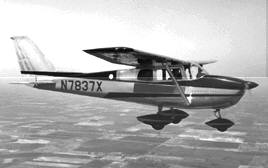
1955-1956:
By the mid-1950's, Cessna's bread-and-butter plane, the Model 170, is facing tough competition from the the competing Piper Pacer taildragger's wildly successful tricycle-gear conversion, the Piper PA-22 "Tri-Pacer" (see 1951, above). Responding, Cessna develops tricycle landing gear for its taildragger Model 170, creating the much-more-popular Cessna 172. This simple improvement to the 170 soon proves to be one of the biggest events in general aviation history. The 4-seat, 125mph Cessna 172 (deluxe model: "Skyhawk") soon becomes the most popular light plane design in the history of the world. Smaller and larger variations of the 172 and its kin will also sell in the tens of thousands. By the early 1960's, Cessna will have displaced Piper as the world's leading maker of light airplanes. The key variants of the 172 theme are ...
172/Skyhawk
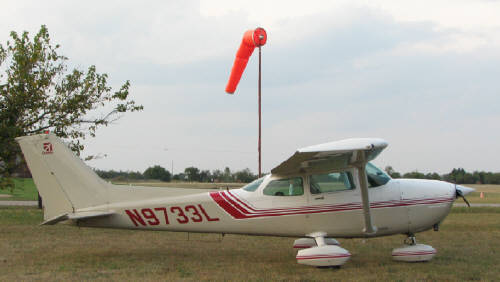 172/Skyhawk: 3-4 seats, 145-165hp, 120-140mph. The basic 172/Skyhawk, though a 4-seater, lacked enough power to lift full fuel and four people. Typically thought of as a 3-seat airplane by pilots, it nevertheless can carry four people, on short trips with less-than-full tanks. Since most owner-pilots fly alone, or with just one other person, and only occasionally want 4 aboard, this "mission flexibility" goes over well with the customers.
172/Skyhawk: 3-4 seats, 145-165hp, 120-140mph. The basic 172/Skyhawk, though a 4-seater, lacked enough power to lift full fuel and four people. Typically thought of as a 3-seat airplane by pilots, it nevertheless can carry four people, on short trips with less-than-full tanks. Since most owner-pilots fly alone, or with just one other person, and only occasionally want 4 aboard, this "mission flexibility" goes over well with the customers.
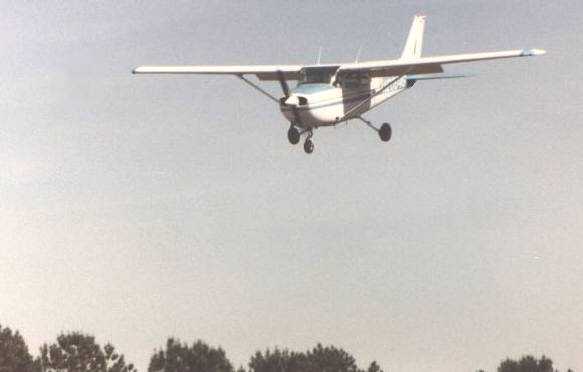 Furthermore, Cessna's big "Para-Lift" flaps make it well-suited to short airstrips, and slow landing approaches -- expanding accessibility and safety. Combined with the tricycle gear, and a host of other subtle, safe touches (including "Omni-Vision" rear windows added in 1963), the 172 earns a reputation for exceptional safety by lightplane standards. Flying Magazine, after an exhaustive study of U.S. general-aviation accident data around the turn of the century, declared the 172 the "Safest Single-Engine General Aviation Airplane."
Furthermore, Cessna's big "Para-Lift" flaps make it well-suited to short airstrips, and slow landing approaches -- expanding accessibility and safety. Combined with the tricycle gear, and a host of other subtle, safe touches (including "Omni-Vision" rear windows added in 1963), the 172 earns a reputation for exceptional safety by lightplane standards. Flying Magazine, after an exhaustive study of U.S. general-aviation accident data around the turn of the century, declared the 172 the "Safest Single-Engine General Aviation Airplane."
Its economy, flexibility and safety endear the 172 to flight schools and aircraft rental services. Even the U.S. Air Force picks the 172 as the primary trainer for its pilots, as the T-41 Mescalero. In Europe, too, the 172 (in various versions made by French partner Reims Aviation) is the top-selling airplane, including a 200-horsepower version called the Reims Rocket, with a constant-speed (variable-pitch) propellor to get maximum performance from the engine.
Higher-horsepower versions are built in the United States, as well. The first, in 1958, is the 175/Skylark -- a 172 fitted with a constant-speed propeller, driven by a Continental GO-300 geared engine. The gearing makes it possible for the 150-horsepower Continental 0-300 engine to run faster, producing 175 horsepower (hence the airplane model number), but at a severe cost in engine life. The 175 was dropped in 1963. Later higher-power models become available, using normal, non-geared engines. The first is the 195-hp Hawk XP. Largely to meet demand from training schools, a retractable-geared version -- the Cutlass RG (for Retractable Gear) is built in the 1980's, with a 180-hp engine -- zooming along at up to 165mph. The continuing demand for a high-powered fixed-gear 172 leads Cessna to offer a non-retractable Cutlass the following year. None of the high-powered, fixed-gear 'Hawks is much faster than the standard model, but the improved weight lifting, take-off and climb performance make the difference for hundreds of buyers.
Nevertheless, the standard 172/Skyhawk -- basic, efficient, and flexible -- remains the most popular Cessna of all. The 172 quickly becomes the best-selling civilian airplane of all time. (With over 30,000 sold, to date, it even outnumbers most military aircraft designs. Only a handful of military fighters -- mostly from World War II -- have been produced in greater numbers.)
When Cessna decides to reintroduce single-engine light planes, in the late 1990's, it finds thousands of eager buyers for new Skyhawks, and the first model off the new single-engine production line in Independence, Kansas is a 172/Skyhawk. For extra power, it is soon joined by the new 180-hp 172/Skyhawk SP.

182/Skylane:
(1956) 4 seats, 235hp, 150-165mph. A beefier Skyhawk, or a tricycle-geared early Model 180, depending on how you look at it. Essentially began life as a tricycle-gear adaptation of the stout Model 180 taildragger, but gradually evolved towards the appearance of the 172.
With enough horsepower (230hp) to lift full fuel and four people, and cruise competitively with retractable-geared airplanes (140-160mph), the "no compromises" Skylane develops a reputation for being able to haul almost anything, from almost anywhere, quickly and reliably.
Though not flawless, the 182 also develops a great reputation for safety, like the 172 before it, having the same wing and flaps, spring-steel tricycle landing gear, and stable flying characteristics -- but with the added benefit of extra horsepower (optimized by a constant-speed propellor) to quickly drag the plane out of hazardous situations. A rear window is added in 1962. The weight of the plane -- coupled with the stability from its long wing and tail -- makes it a fine, stable "instrument platform" for blind-flying by instruments in bad weather.
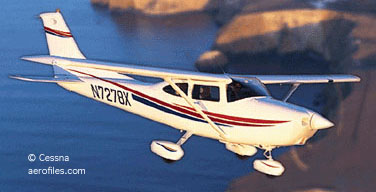 The 182/Skylane soon becomes the most-desired single-engine plane in the world, despite its considerably greater cost than the 172 (which less-wealthy pilots often buy as an affordable substitute for the expensive 182) -- and despite its relatively high drag and fuel consumption, compared to competing airplanes (which include the Piper Cherokee 235/Dakota, the American Aviation AA-5B Tiger, and the Beech Musketeer Super / Sierra.
The 182/Skylane soon becomes the most-desired single-engine plane in the world, despite its considerably greater cost than the 172 (which less-wealthy pilots often buy as an affordable substitute for the expensive 182) -- and despite its relatively high drag and fuel consumption, compared to competing airplanes (which include the Piper Cherokee 235/Dakota, the American Aviation AA-5B Tiger, and the Beech Musketeer Super / Sierra.
It also faces competition from the retractable-geared Beech Model 33 and 35 Bonanza, Piper Comanche and Cherokee Arrow, and Aero Commander 114. The 182 even faces competition from tail-dragging bush planes, including the Maule Jetasen and Cessna's own Skywagon 180.)
 The Skylane prevails, outselling each of them. Challenging the sleeker 4-seat retractables on the market, like the Piper Arrow, Mooney 201 and Beech Bonanza, Cessna even offers a retractable-geared version -- the 182/Skylane RG (for Retractable Gear), yielding competitive speed.
The Skylane prevails, outselling each of them. Challenging the sleeker 4-seat retractables on the market, like the Piper Arrow, Mooney 201 and Beech Bonanza, Cessna even offers a retractable-geared version -- the 182/Skylane RG (for Retractable Gear), yielding competitive speed.
In all, well over 20,000 of the 182/Skylanes are built and sold over the next three decades. By 1986, for broad economic reasons, the Cessna factory will halt production of all its propellor-driven aircraft, including the 182 -- but used Skylanes will continue to command nearly-new prices. When Cessna decides to re-enter the single-engine piston-powered market, in 1997, it starts by re-introducing the 182 (right). Despite a $100,000 price tag, the Skylane resumes its place as the most-sought-after high-performance general aviation single-engine airplane -- nearly a half-century after its introduction.

205 SuperSkylane (1962) and Skywagon 206 / Stationair6: (1963)
6 seats, 260-285hp, 160-180mph (top speed 170-195mph). Looking like a fixed-gear 210 (see below), the Model 205 SuperSkylane(right) is originally certifed as the Model 210-5. Actually, though, it a stretched 182/Skylane. It is valued for its reliability, sturdiness, and low maintenance costs, and above all for its massive hauling capacity.
 After only a year in prodcution, it becomes evident that more power is needed, given the way that operators are stuffing heavy loads into the big cabin. Cessna addresses the problem by adapting the Skywagon 185 taildragger to the tricycle gear, swept tail and rear windows of the Model 205. Thus is born the Skywagon 206 (later also named the Stationair 6) (left, and below). With 285 horsepower, the 206 can lift 1,100 pounds -- over a half a ton -- of fuel, crew, passengers and cargo. This is definitely a working airplane -- extremely popular where heavy lifting is needed.
After only a year in prodcution, it becomes evident that more power is needed, given the way that operators are stuffing heavy loads into the big cabin. Cessna addresses the problem by adapting the Skywagon 185 taildragger to the tricycle gear, swept tail and rear windows of the Model 205. Thus is born the Skywagon 206 (later also named the Stationair 6) (left, and below). With 285 horsepower, the 206 can lift 1,100 pounds -- over a half a ton -- of fuel, crew, passengers and cargo. This is definitely a working airplane -- extremely popular where heavy lifting is needed.
One of the most sought-after bush and cargo planes, the 206 quickly becomes in high demand worldwide. In many remote places where water is more available than good landing fields, the 206 is fitted with pontoon floats -- becoming one of the most popular and hard-working seaplanes of all time. The 206 becomes Cessna's most respected and popular tricycle-geared "workhorse." Commonly used by air-charter services, short-haul air-cargo operations, and air-taxi operations, the 206 is a basic money-making airplane. Industrial and agricultural users, too, find it a first-class flying pickup truck, as long as fields are smooth enough to accomodate the 206's sturdy tricycle gear.
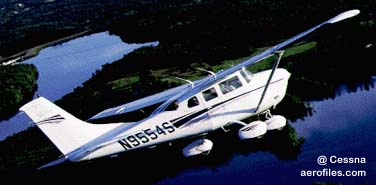 Worldwide, the 206 becomes one of the most heavily-used lightplanes of all time. Many are flown daily. Because of its extremely productive use, the 206 becomes one of the most important lightplanes of all time. By the time Cessna suspends all propellor aircraft production in 1986, over 7,500 of the 206/Stationairs have been built (in fact, demand and order-backlogs for the 206 are so great, that Cessna postpones shutting down the 206 line until late 1987 to fulfill long-standing orders).
Worldwide, the 206 becomes one of the most heavily-used lightplanes of all time. Many are flown daily. Because of its extremely productive use, the 206 becomes one of the most important lightplanes of all time. By the time Cessna suspends all propellor aircraft production in 1986, over 7,500 of the 206/Stationairs have been built (in fact, demand and order-backlogs for the 206 are so great, that Cessna postpones shutting down the 206 line until late 1987 to fulfill long-standing orders).
When Cessna resumes limited production of single-engine planes in 1997, the 206 is one of the three models the company chooses (along with the 172 and 182) to re-introduce. Orders come in by the hundreds.
SuperSkywagon 207 / Stationair7 / Stationair8:
 (1964, 1969) 7-8 seats, 300-310hp, 160-185mph (top speed 195mph). Cessna likes to stretch things. This grand plane is a stretched 206 Stationair (which, of course, is essentially a tricycle-geared Skywagon 185, which in turn is a stretched Model 180, which is a beefed-up Model 170, which is a stretched 120/140 -- remember?). Capable of a massive useful load (fuel, people and cargo) of up to 1,700 pounds -- well over three-quarters of a ton -- the 7-8 seat SuperSkywagon is an awesome hauler.
(1964, 1969) 7-8 seats, 300-310hp, 160-185mph (top speed 195mph). Cessna likes to stretch things. This grand plane is a stretched 206 Stationair (which, of course, is essentially a tricycle-geared Skywagon 185, which in turn is a stretched Model 180, which is a beefed-up Model 170, which is a stretched 120/140 -- remember?). Capable of a massive useful load (fuel, people and cargo) of up to 1,700 pounds -- well over three-quarters of a ton -- the 7-8 seat SuperSkywagon is an awesome hauler.
One of the longest single-engine airplanes ever made, the 32-foot-long beast is hauled through the air on essentially the same engine as used in the much-lighter Skywagon 206. At 300 horsepower, though, this piston engine is just about the most powerful engine that will gracefully fit into the 207 airframe, which still uses the same basic structure (and many of the same parts) as the 206. The result is somewhat sluggish takeoff and climb performance.
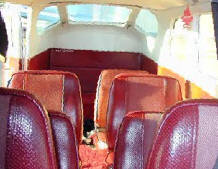 But despite their age and slight performance limitations, the 207's -- long after production ceases in 1986 -- easily command prices well above what they originally sold for. Big, double cargo doors (below, left) are commonly installed, and welcome almost anything you can think to put through them. With enormous hauling capacity -- in both people and cargo -- and the low-altitude efficiency of piston engines, they are very profitable airplanes for small, short-haul cargo operations and air taxi services. By 2002, good used units, though over a decade and a half old, will typically be priced at upwards of $170,000, and in great demand.
But despite their age and slight performance limitations, the 207's -- long after production ceases in 1986 -- easily command prices well above what they originally sold for. Big, double cargo doors (below, left) are commonly installed, and welcome almost anything you can think to put through them. With enormous hauling capacity -- in both people and cargo -- and the low-altitude efficiency of piston engines, they are very profitable airplanes for small, short-haul cargo operations and air taxi services. By 2002, good used units, though over a decade and a half old, will typically be priced at upwards of $170,000, and in great demand.
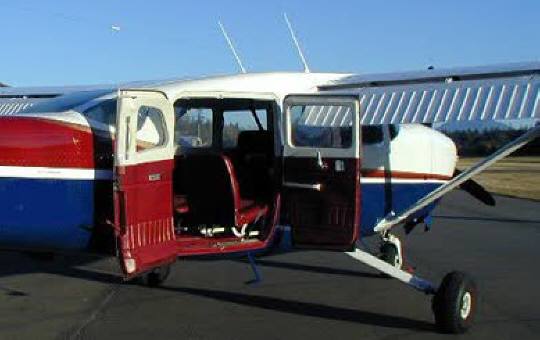 Though only about 550 of the SuperSkywagon's three versions are built before the line is shut down during the 1980's recession, the demand for this high-priced hauler proves there is a demand for a much-larger, more-powerful, single-engine, utility airplane -- a lesson Cessna will respond to a decade later with the radically-different 208 Caravan.
Though only about 550 of the SuperSkywagon's three versions are built before the line is shut down during the 1980's recession, the demand for this high-priced hauler proves there is a demand for a much-larger, more-powerful, single-engine, utility airplane -- a lesson Cessna will respond to a decade later with the radically-different 208 Caravan.
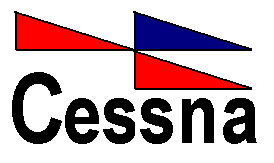 The various strut-winged tricycle Cessnas go on to become the most popular line of aircraft in world history -- with over 100,000 of them built before the end of production in the Great Recession of the 1980's. In the late 1990's, though, Cessna -- bowing to popular demand -- brings the line back into production, with the 172/Skyhawk, the 172SP (a 172 with extra horsepower), the 182/Skylane, and the Stationair 206.
The various strut-winged tricycle Cessnas go on to become the most popular line of aircraft in world history -- with over 100,000 of them built before the end of production in the Great Recession of the 1980's. In the late 1990's, though, Cessna -- bowing to popular demand -- brings the line back into production, with the 172/Skyhawk, the 172SP (a 172 with extra horsepower), the 182/Skylane, and the Stationair 206.
 Return to Cessna History Timeline
Return to Cessna History Timeline
Return to Aviation Answer-Man Gateway



 Return to Cessna History Timeline
Return to Cessna History Timeline


 172/Skyhawk: 3-4 seats, 145-165hp, 120-140mph. The basic 172/Skyhawk, though a 4-seater, lacked enough power to lift full fuel and four people. Typically thought of as a 3-seat airplane by pilots, it nevertheless can carry four people, on short trips with less-than-full tanks. Since most owner-pilots fly alone, or with just one other person, and only occasionally want 4 aboard, this "mission flexibility" goes over well with the customers.
172/Skyhawk: 3-4 seats, 145-165hp, 120-140mph. The basic 172/Skyhawk, though a 4-seater, lacked enough power to lift full fuel and four people. Typically thought of as a 3-seat airplane by pilots, it nevertheless can carry four people, on short trips with less-than-full tanks. Since most owner-pilots fly alone, or with just one other person, and only occasionally want 4 aboard, this "mission flexibility" goes over well with the customers.
 Furthermore, Cessna's big "Para-Lift" flaps make it well-suited to short airstrips, and slow landing approaches -- expanding accessibility and safety. Combined with the tricycle gear, and a host of other subtle, safe touches (including "Omni-Vision" rear windows added in 1963), the 172 earns a reputation for exceptional safety by lightplane standards. Flying Magazine, after an exhaustive study of U.S. general-aviation accident data around the turn of the century, declared the 172 the "Safest Single-Engine General Aviation Airplane."
Furthermore, Cessna's big "Para-Lift" flaps make it well-suited to short airstrips, and slow landing approaches -- expanding accessibility and safety. Combined with the tricycle gear, and a host of other subtle, safe touches (including "Omni-Vision" rear windows added in 1963), the 172 earns a reputation for exceptional safety by lightplane standards. Flying Magazine, after an exhaustive study of U.S. general-aviation accident data around the turn of the century, declared the 172 the "Safest Single-Engine General Aviation Airplane."

 The 182/Skylane soon becomes the most-desired single-engine plane in the world, despite its considerably greater cost than the 172 (which less-wealthy pilots often buy as an affordable substitute for the expensive 182) -- and despite its relatively high drag and fuel consumption, compared to competing airplanes (which include the Piper Cherokee 235/Dakota, the American Aviation AA-5B Tiger, and the Beech Musketeer Super / Sierra.
The 182/Skylane soon becomes the most-desired single-engine plane in the world, despite its considerably greater cost than the 172 (which less-wealthy pilots often buy as an affordable substitute for the expensive 182) -- and despite its relatively high drag and fuel consumption, compared to competing airplanes (which include the Piper Cherokee 235/Dakota, the American Aviation AA-5B Tiger, and the Beech Musketeer Super / Sierra.
 The Skylane prevails, outselling each of them. Challenging the sleeker 4-seat retractables on the market, like the Piper Arrow, Mooney 201 and Beech Bonanza, Cessna even offers a retractable-geared version -- the 182/Skylane RG (for Retractable Gear), yielding competitive speed.
The Skylane prevails, outselling each of them. Challenging the sleeker 4-seat retractables on the market, like the Piper Arrow, Mooney 201 and Beech Bonanza, Cessna even offers a retractable-geared version -- the 182/Skylane RG (for Retractable Gear), yielding competitive speed.

 After only a year in prodcution, it becomes evident that more power is needed, given the way that operators are stuffing heavy loads into the big cabin. Cessna addresses the problem by adapting the Skywagon 185 taildragger to the tricycle gear, swept tail and rear windows of the Model 205. Thus is born the Skywagon 206 (later also named the Stationair 6) (left, and below). With 285 horsepower, the 206 can lift 1,100 pounds -- over a half a ton -- of fuel, crew, passengers and cargo. This is definitely a working airplane -- extremely popular where heavy lifting is needed.
After only a year in prodcution, it becomes evident that more power is needed, given the way that operators are stuffing heavy loads into the big cabin. Cessna addresses the problem by adapting the Skywagon 185 taildragger to the tricycle gear, swept tail and rear windows of the Model 205. Thus is born the Skywagon 206 (later also named the Stationair 6) (left, and below). With 285 horsepower, the 206 can lift 1,100 pounds -- over a half a ton -- of fuel, crew, passengers and cargo. This is definitely a working airplane -- extremely popular where heavy lifting is needed.
 Worldwide, the 206 becomes one of the most heavily-used lightplanes of all time. Many are flown daily. Because of its extremely productive use, the 206 becomes one of the most important lightplanes of all time. By the time Cessna suspends all propellor aircraft production in 1986, over 7,500 of the 206/Stationairs have been built (in fact, demand and order-backlogs for the 206 are so great, that Cessna postpones shutting down the 206 line until late 1987 to fulfill long-standing orders).
Worldwide, the 206 becomes one of the most heavily-used lightplanes of all time. Many are flown daily. Because of its extremely productive use, the 206 becomes one of the most important lightplanes of all time. By the time Cessna suspends all propellor aircraft production in 1986, over 7,500 of the 206/Stationairs have been built (in fact, demand and order-backlogs for the 206 are so great, that Cessna postpones shutting down the 206 line until late 1987 to fulfill long-standing orders).
 (1964, 1969) 7-8 seats, 300-310hp, 160-185mph (top speed 195mph). Cessna likes to stretch things. This grand plane is a stretched 206 Stationair (which, of course, is essentially a tricycle-geared Skywagon 185, which in turn is a stretched Model 180, which is a beefed-up Model 170, which is a stretched 120/140 -- remember?). Capable of a massive useful load (fuel, people and cargo) of up to 1,700 pounds -- well over three-quarters of a ton -- the 7-8 seat SuperSkywagon is an awesome hauler.
(1964, 1969) 7-8 seats, 300-310hp, 160-185mph (top speed 195mph). Cessna likes to stretch things. This grand plane is a stretched 206 Stationair (which, of course, is essentially a tricycle-geared Skywagon 185, which in turn is a stretched Model 180, which is a beefed-up Model 170, which is a stretched 120/140 -- remember?). Capable of a massive useful load (fuel, people and cargo) of up to 1,700 pounds -- well over three-quarters of a ton -- the 7-8 seat SuperSkywagon is an awesome hauler.
 But despite their age and slight performance limitations, the 207's -- long after production ceases in 1986 -- easily command prices well above what they originally sold for. Big, double cargo doors (below, left) are commonly installed, and welcome almost anything you can think to put through them. With enormous hauling capacity -- in both people and cargo -- and the low-altitude efficiency of piston engines, they are very profitable airplanes for small, short-haul cargo operations and air taxi services. By 2002, good used units, though over a decade and a half old, will typically be priced at upwards of $170,000, and in great demand.
But despite their age and slight performance limitations, the 207's -- long after production ceases in 1986 -- easily command prices well above what they originally sold for. Big, double cargo doors (below, left) are commonly installed, and welcome almost anything you can think to put through them. With enormous hauling capacity -- in both people and cargo -- and the low-altitude efficiency of piston engines, they are very profitable airplanes for small, short-haul cargo operations and air taxi services. By 2002, good used units, though over a decade and a half old, will typically be priced at upwards of $170,000, and in great demand.
 Though only about 550 of the SuperSkywagon's three versions are built before the line is shut down during the 1980's recession, the demand for this high-priced hauler proves there is a demand for a much-larger, more-powerful, single-engine, utility airplane -- a lesson Cessna will respond to a decade later with the radically-different 208 Caravan.
Though only about 550 of the SuperSkywagon's three versions are built before the line is shut down during the 1980's recession, the demand for this high-priced hauler proves there is a demand for a much-larger, more-powerful, single-engine, utility airplane -- a lesson Cessna will respond to a decade later with the radically-different 208 Caravan.
 The various strut-winged tricycle Cessnas go on to become the most popular line of aircraft in world history -- with over 100,000 of them built before the end of production in the Great Recession of the 1980's. In the late 1990's, though, Cessna -- bowing to popular demand -- brings the line back into production, with the 172/Skyhawk, the 172SP (a 172 with extra horsepower), the 182/Skylane, and the Stationair 206.
The various strut-winged tricycle Cessnas go on to become the most popular line of aircraft in world history -- with over 100,000 of them built before the end of production in the Great Recession of the 1980's. In the late 1990's, though, Cessna -- bowing to popular demand -- brings the line back into production, with the 172/Skyhawk, the 172SP (a 172 with extra horsepower), the 182/Skylane, and the Stationair 206.
 Return to Cessna History Timeline
Return to Cessna History Timeline
